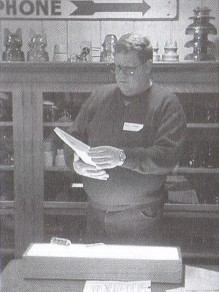The Color Corner
by Ernie Carlson
Reprinted from "Crown Jewels of the Wire", April 2002, page 7
Hello Everyone, and welcome again to this column on my favorite subject -
Color! As you may recall, in my last column I issued the following challenge to
insulator clubs: I will donate a Spec-Tru color identification kit to every club
that is willing to provide a standard light source for color identification at
their next show. So far, only the Greater Chicago Insulator Club has accepted my
challenge. Thanks, Russ Frank.

Russ Frank built the standard light source box
and helped GCIC club members
work through the
Spec-Tru color identification for an olive
green CD 133 Star.
(Photo by Marge Frank)

What Color is that Two-Tone?
I recently acquired a blue and green
Hemingray-42 from Montie McDowell. When I placed it on my light box, I was
surprised to see that the 'green' coloration was caused by heavy amber streaks in the Hemingray Blue glass (yellow + blue = green). Although
it certainly looks green in my window, there is no 'green' glass in this
insulator. Curious as to how many other insulators have this same coloration, I
asked Montie how many 154's he found with amber streaks in them. Well, between
Montie and Pat Scott, 86 of these beauties have been rescued from the same
railroad line over the years, and all of them appear to have amber streaks in
the same general location - vertically, at the (left) mold line between USA and
Hemingray. I wonder if this was caused by a rusty mold? But, my real question
is: are these really blue/green two-tones? Or should they be called blue/amber
two-tones? Or just Hemingray Blue with heavy Amber streaks? And, how did the
listing in the Price Guide get generated - are there really blue + green
Hemi-42's out there? This 'name game' may seem picky, but it's just my pursuit
of the most accurate color description that is possible. Send me an e-mail and
vote for your choice! Regardless of the name we give them, I don't think it
affects their rarity or value - they are still a knockout in my display!
Travels with Charley
This Fall I took a three-week road trip in order to
attend the Enchantment Insulator Club's annual show and sale in Albuquerque, New
Mexico. At the show I was able to verify Spec-Tru color descriptions for Apple
Green, Lime Green, and Depression Glass Green H.G. Co. beehives, with the
assistance of Al Riddell and Duane Davenport. Also, Duane straightened me out on
the differences between California 'Plum' and 'Burgundy', which requires changes
to my color index. Thanks Al and Duane for your continued help and support! As I
collect many different types of colored glass besides insulators, I was
fascinated by Tom Katonak's display of Australian piano insulators, which come
in a variety of shapes and colors. Oh boy, something else to collect.....
Things to Come...
A Canadian pony collection may grace these pages sometime
this year. Dudley Ellis's goals are to document the colors of skirt-numbered
Diamond ponies and to document the colors of each mold style of the Diamond
pony, and publish the results. Hopefully, the color photos that accompany his
article will include Spec-Tru slide combinations with the color description,
providing us with yet another way to get 'smart' about color. I'm looking
forward to helping in any way I can with the color identification.
|
